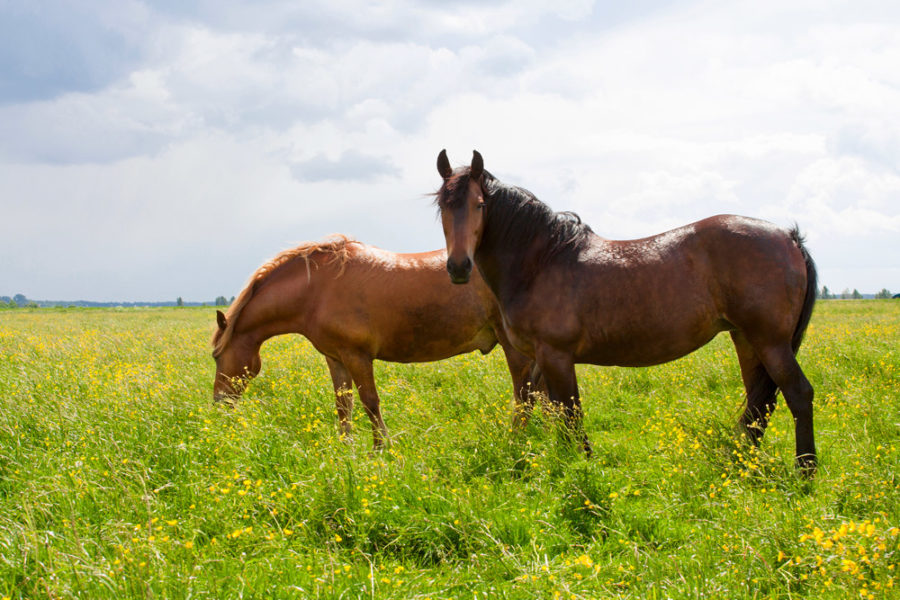Understanding abnormal equine posture and how rehabilitation intervention can help.
Why should we care about posture in horses? Because posture affects the complex interactions of the brain, muscles, nerves and skeletal system. In our clinical experience, abnormal compensatory postures (ACP) are associated with poor performance and training problems, body distortion, chronic lameness, impaired nerve signaling, poor gait timing, predisposition to injury, delayed healing and pervasive physical and emotional stress.
Normal neutral posture
Most domestic horses spend much more time standing than they do moving. The average horse is ridden an hour a day and lies down briefly for REM sleep, but spends as many as 22 hours a day standing. Therefore, his stance can have a larger influence on his body mechanics and soundness than his exercise program!
The standing posture observed in a normal, sound horse at rest is called Normal Neutral Posture (NNP). Neutral stance balances and stabilizes the body’s center of mass, allowing for rapid, accurate mobilization when necessary.
What does NNP look like?
When horses are standing on level ground, all four cannon bones should be perpendicular to the ground. Because horses are large and must be efficient, their anatomy allows them to use passive support to minimize the energy needed to support their weight. Standing with vertical limbs loads the horse’s weight like the legs of a table. A horse using NNP does not need to activate all his muscles to maintain stance, thereby saving more energy for non-passive functions like locomotion. Standing with the limbs vertical also strengthens bones, muscles and ligaments in the correct orientation for withstanding the highest forces during movement.
NNP also organizes the muscles of the back, which determines the spinal contour. In neutral stance, the muscles underneath the saddle can be soft and relaxed, since deeper postural muscles are providing the necessary support. A neutral spinal contour is lowest right behind the withers, and slopes gently up to the top of the croup, without a pronounced “roached back” or “jumper’s bump”.
Abnormal Compensatory Postures (ACP) and emotional health
ACP is observed to be associated with emotional dysregulation: becoming hyper-reactive, or becoming “shut down” and unresponsive. This may be caused by long-term disruption of the mind-body-emotion integration, parallel to that seen in human victims of illness, trauma, abuse and neglect. Recent research has shown certain postures to be associated with specific behaviors in horses, and spinal pain (frequently caused by ACP) to be associated with aggressiveness. Postural correction can help resolve these emotional issues.
How can we improve abnormal standing postures?
Many therapeutic modalities alter neural regulation to make changes in physiology, mechanics and emotion. These include osteopathy, acupuncture, chiropractic and physical therapy as well as allopathic medicine. However, none of these have the specific goal of restoring neutral posture. Postural Rehabilitation Intervention (PRI), a therapy protocol developed by Dr. Judith M. Shoemaker, is influenced by the Alexander Technique in humans, as interpreted by Elizabeth Reese, Certified Teacher of the Alexander Technique, a long-time AT practitioner and classical rider. Both AT and PR practitioners:
- Focus on postural resilience and stability as the foundation for freedom of movement.
- Understand that the dynamic relationship of the head/neck and back is central to good integration.
- Encourage dynamic expansion while using the musculoskeletal system, making physical function, especially breathing, more balanced and effective.
- Use intentional, directed touch to convey changes to a patient’s neuromuscular patterns, improving neurologic function, body confidence and poise, which reduces chronic stress.
To support the functional changes achieved by Postural Rehabilitation, it is critical to have correct hoof balance, and accurate occlusal equilibration (a skilled dental procedure that results in TMJ neutrality) for long term postural stability.
Study results show value of posture correction
Maximum Horsepower Research’s recent study, funded by the American Holistic Veterinary Medical Foundation, examined abnormal and neutral posture in horses and the interventions that changed them. The eight horses in the study initially exhibited one or more of the most common signs of ACP, and were treated with PR manual therapy, correctly balanced hoof trims, and accurate occlusal equilibration. We learned that standing in ACP is more energetically costly than NNP, and that hooves can be rapidly returned to mechanical balance, even without using shoes. The most elderly subject, a 29-year-old Arab mare with compromised dentition, poor condition and evidence of chronic laminitis, looked years younger after the study!
Helping your horse maintain NNP is critical for his health, soundness and longevity, especially if he is healing from injury. Even if your vet does not have training in Postural Rehabilitation, he or she can help correct structural problems with accurate dental occlusal equilibration (or help you find someone with the appropriate skill to do so). Your farrier can balance the horse’s weight-bearing surface around the center of articulation of the coffin joint. You can provide the most natural diet possible, and turnout in an area with varied terrain. In addition, manual therapies such as chiropractic or osteopathy, which promote the neutral, unrestricted movement of the upper neck and spine, can help the horse reset his Normal Neutral Posture.








